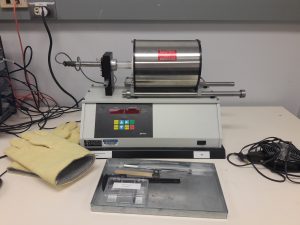
When materials are heated, there is usually an accompanying change in dimension as the atoms vibrate more. Students measure the expansion of four materials (two glasses and two metals) when they are heated to about 600C, and compare their experimental thermal expansion coefficients to published values. They also determine the elastic modulus of these same materials by recording and analyzing the sound generated when a suspended bar is struck with a mallet (following ASTM Standard E1876-09). At the end of the experiment, students consider the best pairings for glass-metal seals among the four materials tested, trying to minimize the thermal stresses and strains that may develop.
PROCEDURE – THERMAL STRESS AND STRAIN
Equipment Used
- Orton Dilatometer and associated software
- Ring stands, mallet, and string
- Microphone connected to Audacity software
- Fan and stand for cooling dilatometer
Materials Tested
- Titanium
- Kovar
- Soda-lime glass
- Borosilicate glass